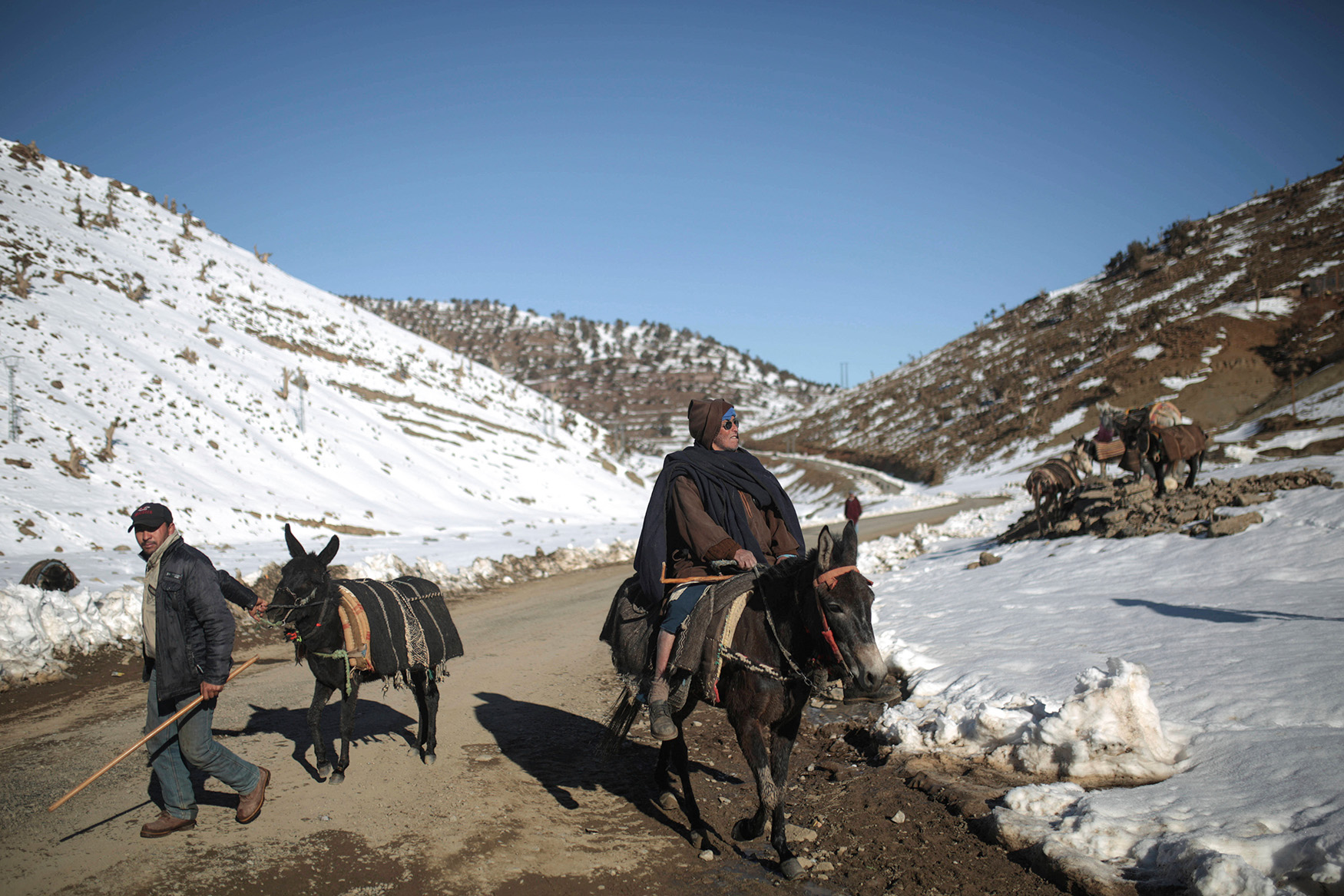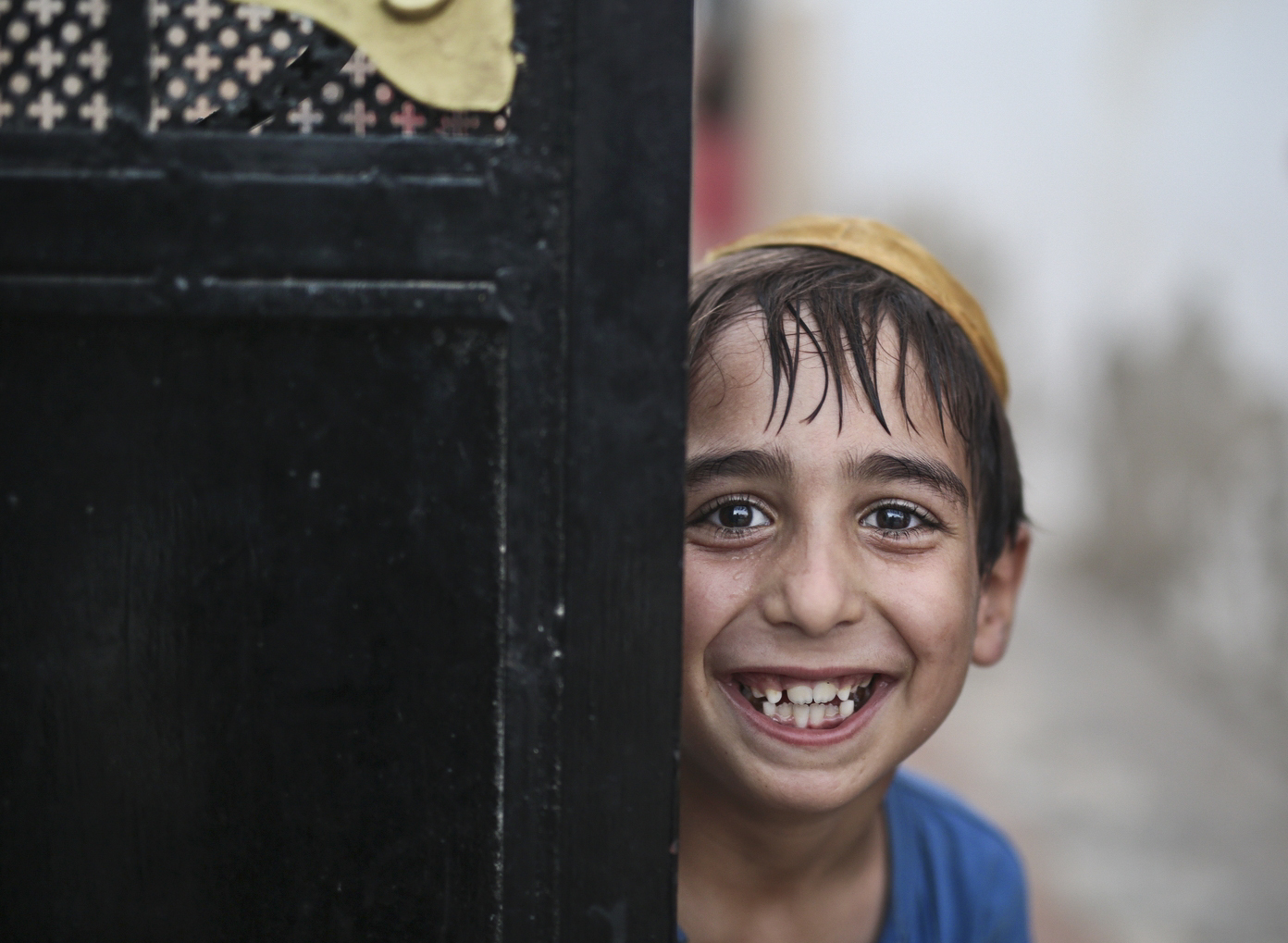Snow isolates Moroccan mountain villages used to sun

Bitter cold and exceptionally heavy snowfall have beleaguered parts of Morocco this winter, disrupting schools, closing national highways — and delighting residents in cities where it hadn’t snowed for decades.
The effects are starkest in the north African nation’s Middle Atlas mountains, home to many hard-to-reach villages with poor infrastructure. The range that once protected local Amazigh tribes from attacks now isolates remote hillside villages, often for months on end.
Getting in or out of the hill towns hidden among dense forests and peaks over 3,000 meters (9,800 feet) high is never easy — many of the narrow, treacherous lanes can only be traversed by four-wheel-drive vehicles, donkeys or more typically, on foot.
In this Wednesday, Feb. 14, 2018 photo, a Berber village, Tighanmin, is surrounded by snow covered mountains in the Middle Atlas, near Azilal, central Morocco. (AP Photo/Mosa'ab Elshamy)
This year, the 150 families living in Tighanimin, a village 311 miles (500 kilometers) south of the Moroccan capital, Rabat, were marooned when the rocky mountain paths disappeared under three feet of snow. Temperatures routinely plummet below zero degrees Celcius (32 degrees Celsius) after sundown, and the homes aren’t equipped with electricity or running water.
“The children gather in one corner of the house to avoid the snowfall,” Mustafa Oulhassan, 68, said.
In this Wednesday, Feb. 14, 2018 photo, Mouhcine, 11, enjoys sledging on snow covered mountains in Tighanmin, a Middle Atlas village near Azilal, central Morocco. (AP Photo/Mosa'ab Elshamy)
Children of the village attend school throughout the winter, walking some 1.2 miles to the nearest primary school.
The majority of Tighanimnin’s residents are shepherds, the only source of income in the village, according to Saeed Ahmad, a 39-year-old father-of-five.
“We can’t harvest plants due to the weather. Since there are no jobs here we have to go to Agadir or Marrakech to find work,” he explained, an impossible prospect while the roads are covered in snow.
In this Wednesday, Feb. 14, 2018 photo, Berber villagers gather in the evening sun in Tighanmin, a Middle Atlas village near Azilal, central Morocco. (AP Photo/Mosa'ab Elshamy)
Most residents spend their days grazing their cattle and collecting water from the nearby river.
“We have to take the cattle very far to find land suitable for grazing and we have to wait for the sun to come out,” said Saeed.
Another resident, a 38-year-old woman who only gave her name as Fatima, chops and loads firewood onto a donkey to create a fire for baking bread, and for warmth through the night.
It’s a tough winter but the heavy snowfall also brought joy, at least for the children of Tighanimin. Youngsters scaled steep mountainsides with plastic bags and sledded down the slopes.
In this Wednesday, Feb. 14, 2018 photo, a family gathers around a fire to warm up inside their home in Tighanmin, a Middle Atlas village near Azilal, central Morocco. (AP Photo/Mosa'ab Elshamy
In the evenings, families reunite by the fireside for meals of bread, olive oil, soup, tea, and occasionally meat.
During winter, the Middle Atlas are far from the burnt orange landscape and warm blue skies familiar to Morocco’s visitors. But the blanket of white shows no signs of receding just yet.
“Sometimes the snow lasts until June or July,” Saeed said. “Sometimes it starts snowing as early as October, but this year it didn’t start until January.”
“It has been very stormy and snowy,” he added. “But once the sun comes out, it’ll be better.”
In this Wednesday, Feb. 14, 2018 photo, a shepherd guides his sheep through snow covered mountains in Tighanmin, a Middle Atlas village near Azilal, central Morocco. (AP Photo/Mosa'ab Elshamy)
In this Wednesday, Feb. 14, 2018 photo, villagers walk through a slope on their way to Tighanmin, a Middle Atlas village near Azilal, central Morocco. (AP Photo/Mosa'ab Elshamy)
In this Wednesday, Feb. 14, 2018 photo, Mostfa Oulhassan, 68, prepares tea for his family inside his home in Tighanmin, a Middle Atlas village near Azilal, central Morocco. (AP Photo/Mosa'ab Elshamy)
In this Wednesday, Feb. 14, 2018 photo, children enjoy sledging after school on snow covered mountains in Tighanmin, a Middle Atlas village near Azilal, central Morocco. (AP Photo/Mosa'ab Elshamy)
In this Wednesday, Feb. 14, 2018 photo, Fatima, 39, chops wood to take it back home for warmth in Tighanmin, a Berber village in the Middle Atlas, near Azilal, central Morocco. (AP Photo/Mosa'ab Elshamy)
In this Wednesday, Feb. 14, 2018 photo, children run down a hill on their way home to Tighanmin, a Middle Atlas village near Azilal, central Morocco. (AP Photo/Mosa'ab Elshamy)
In this Wednesday, Feb. 14, 2018 photo, workers take a rest as they use a vehicle to break through snow near Tighanmin, a Middle Atlas village near Azilal, central Morocco. (AP Photo/Mosa'ab Elshamy)
In this Wednesday, Feb. 14, 2018 photo, Berber villagers gather for warmth in the evening sun in Tighanmin, a Middle Atlas village near Azilal, central Morocco. (AP Photo/Mosa'ab Elshamy)
In this Wednesday, Feb. 14, 2018 photo, Saeed, 42, heads along with his two daughters to collect water for his family in Tighanmin, a Middle Atlas village near Azilal, central Morocco. (AP Photo/Mosa'ab Elshamy)
In this Thursday, Feb. 15, 2018, children play soccer in the snow in Tighanmin, a Middle Atlas village near Azilal, central Morocco. (AP Photo/Mosa'ab Elshamy)
In this Wednesday, Feb. 14, 2018 photo, clothes are put out to dry outside a home after heavy snowfall in Tighanmin, a Middle Atlas village near Azilal, central Morocco. (AP Photo/Mosa'ab Elshamy)
In this Thursday, Feb. 15, 2018 photo, Berber villagers ride their donkeys through snow covered mountains in Tighanmin, a Middle Atlas village near Azilal, central Morocco. (AP Photo/Mosa'ab Elshamy)
In this Thursday, Feb. 15, 2018 photo, a view of snow covered mountains in the Middle Atlas village of Tighanmin, near Azilal, central Morocco. (AP Photo/Mosa'ab Elshamy)
In this Wednesday, Feb. 14, 2018 photo, a woman waits for her family as she prepares dinner in Tighanmin, a Middle Atlas village near Azilal, central Morocco. (AP Photo/Mosa'ab Elshamy)
In this Wednesday, Feb. 14, 2018 photo, a woman walks home after collecting wood and tree leaves in Tighanmin, a Middle Atlas village near Azilal, central Morocco. (AP Photo/Mosa'ab Elshamy)
Text from the AP news story, Snow isolates Moroccan mountain villages more used to sun, by Mosa'ab Elshamy.
Visual artist and Journalist





